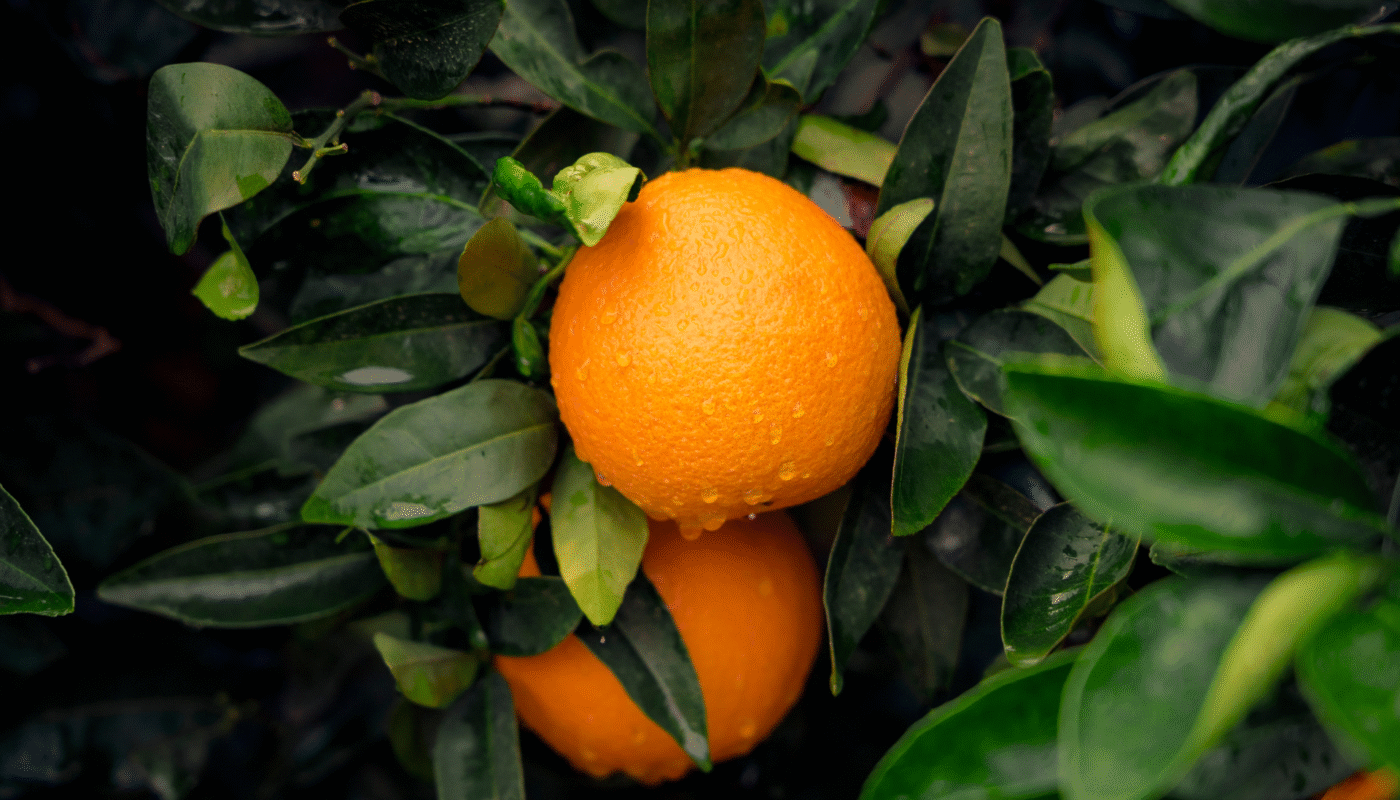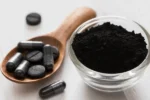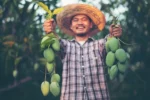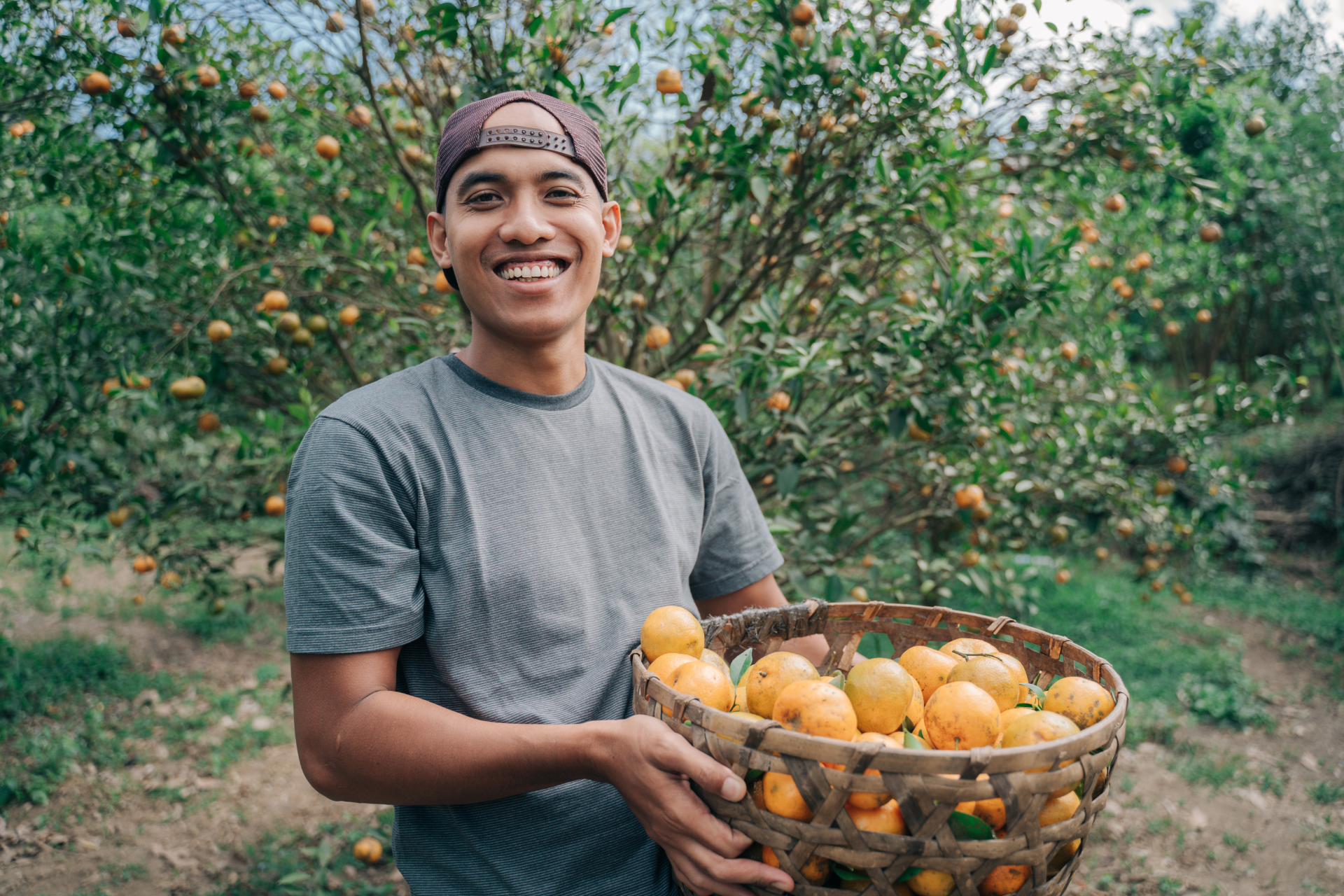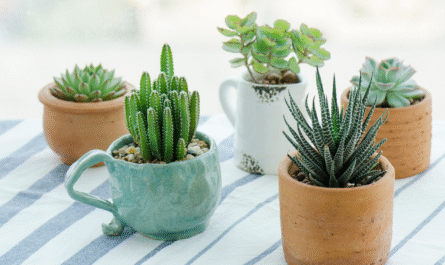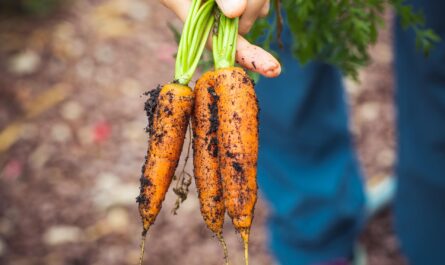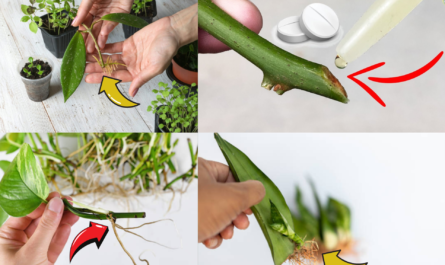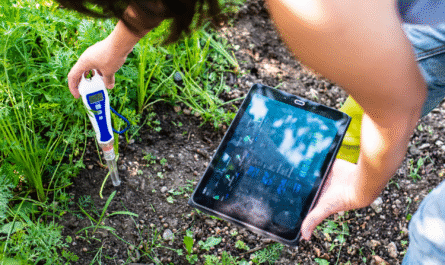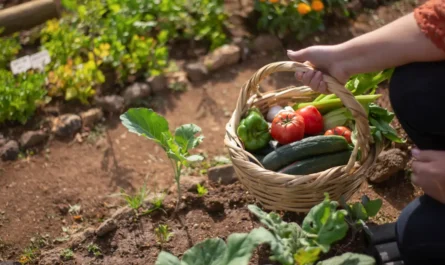Description
Orange, a citrus fruit cherished worldwide, is known for its bright color, zesty aroma, and juicy sweetness. Grown primarily on the orange tree (Citrus × sinensis), this fruit is a staple in global diets, especially in the form of orange juice, one of the most consumed beverages worldwide.
Recognized for its round shape and vibrant peel, the orange stands out for its flavor, rich nutritional content, and economic importance.
The orange tree is an evergreen, flowering plant that thrives in subtropical and tropical climates. Typically reaching heights between 20 and 30 feet, the tree produces dark green, glossy leaves and fragrant white flowers.
The fruit itself develops from the fertilized ovary of the flower and matures into the familiar orange-skinned fruit over several months.
Depending on the cultivar, oranges can be seedless or contain some seeds, and their flesh can range in color from deep orange to crimson red in blood oranges.
Visually appealing and refreshingly sweet, oranges are a source of natural sugars, water, fiber, and vitamins. Their juice is not only a morning ritual in many households but also a base for culinary recipes, sauces, and cocktails.
The orange peel, often discarded, holds aromatic oils and has applications in zesting, perfumery, and cleaning products. Few fruits match the orange in versatility and cultural significance.
Because of its widespread cultivation and consumption, the orange is more than just a fruit — it’s a global agricultural powerhouse. Whether consumed raw, juiced, or processed, it continues to deliver flavor, nutrition, and value across countless households and markets worldwide.
History
Hybrid Origins
Oranges are not wild fruits by origin — they are hybrids, created through centuries of agricultural breeding. The sweet orange (Citrus × sinensis) is a cross between the pomelo (Citrus maxima) and the mandarin (Citrus reticulata). This hybridization is believed to have first occurred in southern China or northern India, areas known for their rich biodiversity and long-standing citrus cultivation practices.
Genetic studies have confirmed that humans played a key role in creating the orange, selecting traits like sweetness, juiciness, and ease of peeling over generations. These early cultivators didn’t just stumble upon a sweet fruit — they engineered it through observation, trial, and selection. The result was a fruit that appealed to taste, stored well, and could be transported over long distances.
Early references to oranges in Chinese literature date back thousands of years. These writings reveal a deep appreciation for the fruit, often tied to wealth, longevity, and celebration. The orange’s hybrid nature also made it resilient to disease and adaptable to different climates — a factor that contributed to its global spread.
As orange cultivation advanced, growers began to understand the complex needs of the orange tree, learning how to grow oranges successfully in varying environments. The hybrid origins laid the genetic foundation for the diverse cultivars available today, from sweet navels to vibrant blood oranges.
Arab Agricultural Revolution
The spread of the orange beyond Asia is closely linked to the Arab Agricultural Revolution, which spanned the 8th to 13th centuries. During this time, Islamic scholars and farmers introduced advanced irrigation, grafting, and cultivation techniques across the Middle East, North Africa, and parts of Europe. Oranges were part of this transformation.
Arab traders and botanists valued citrus for both its flavor and medicinal properties. They established orange orchards in Persia, Iraq, and Egypt, where sophisticated irrigation systems allowed orange trees to thrive in arid climates. The sweet orange eventually became a prized commodity, traded and planted wherever water and soil conditions permitted.
Arabic texts from this period describe different types of oranges, including sour and sweet varieties. These records also highlight the orange’s role in culinary dishes, perfumes, and healing tonics. The orange’s pleasant aroma and acidic punch made it a favorite in both kitchens and apothecaries.
By cultivating oranges systematically and spreading the knowledge of how to grow orange trees across continents, the Arab world played a pivotal role in the fruit’s journey westward. Their agricultural innovation set the stage for oranges to flourish in Europe and beyond.

Spread Across Europe
The orange entered Europe through Spain and Italy, regions influenced heavily by Arab rule. Initially, sour oranges (Citrus aurantium) dominated the landscape and were used more for medicinal and decorative purposes. Sweet oranges made their debut in Europe around the 15th century, likely introduced by Portuguese or Italian traders returning from Asia.
As trade routes expanded and seafaring improved, oranges became an elite fruit among European aristocrats. Orangeries — special greenhouse-like structures — were built on noble estates to house orange trees during colder months. These structures symbolized wealth, power, and a connection to exotic lands.
The Mediterranean climate proved ideal for cultivating orange trees. Southern Spain, in particular, emerged as a center of citrus production, where growers honed techniques on how to grow orange trees efficiently and profitably. Orange juice became more available, and the fruit itself began to appear in more European markets.
This continental adoption marked a turning point. No longer confined to royal gardens, the orange became part of European daily life — eaten raw, candied, or juiced. Its popularity paved the way for transatlantic cultivation, particularly in the Americas.
To the Americas
Spanish explorers carried orange seeds to the Americas in the 16th century. The climate in parts of the New World — especially in regions like the Caribbean, Mexico, and South America — proved ideal for orange cultivation. The orange tree took root quickly, supported by warm temperatures and fertile soil.
Oranges adapted well to their new environments. Native populations and European settlers alike embraced the fruit, appreciating its flavor, nutritional value, and versatility. Jesuit missionaries were among the earliest to plant orange groves in areas like Florida and California, using the fruit to support their missions and nourish local communities.
By the 1700s, oranges had become an established crop in parts of North and South America. Local varieties evolved, and new cultivars were developed to suit the climates and tastes of the New World. The orange had completed its journey from hybrid creation in Asia to a global staple in the Americas.
As oranges spread, so too did knowledge about orange juice processing, tree care, and post-harvest storage. What began as a crossbred curiosity now formed the backbone of thriving citrus economies across multiple continents.
California
California’s relationship with the orange began in earnest during the 19th century. The state’s Mediterranean-like climate made it a prime location for citrus farming, and the introduction of the Washington Navel orange in the 1870s revolutionized the industry. Seedless, sweet, and easy to peel, this cultivar was ideal for mass production and export.
Railroads enabled oranges to reach distant markets, especially on the East Coast, turning California into a citrus empire. Cities like Riverside and Redlands became synonymous with orange production, and the orange tree became a symbol of California’s agricultural promise. The state’s booming industry gave rise to cooperatives, marketing campaigns, and scientific farming techniques.
California’s orange groves weren’t just farms — they were cultural landmarks. Advertisements and postcards from the early 1900s often featured orange trees as emblems of prosperity and sunshine. Tourists visited orchards, and orange crate labels became iconic pieces of Americana.
Even today, California remains one of the top producers of oranges in the United States. The state’s legacy is deeply intertwined with the fruit, from its economy to its identity. The Orange’s story in California reflects a broader narrative of innovation, expansion, and resilience.
Etymology
The word “orange” has a fascinating etymological journey that mirrors the fruit’s global path. It stems from the Sanskrit word “nāraṅga,” which passed into Persian as “nārang,” then into Arabic as “nāranj,” before arriving in Old French as “orenge.” From there, it entered the English language around the 14th century.
Interestingly, the English term “orange” was not only applied to the fruit but also eventually to the color, which previously lacked a distinct name in Old English. Before the term “orange” became standard, the color was described as “yellow-red.” The fruit ultimately gave the color its name, not the other way around.
The transition of the word through different languages also reveals how valuable and widespread the fruit was. Each culture adapted the word based on its pronunciation patterns and phonetics, but the root always pointed back to the original Sanskrit term. This linguistic lineage highlights the deep history and significance of the fruit across civilizations.
Language scholars also note the unusual nature of the word “orange” in English, as it lacks a true rhyme — a quirk that has intrigued poets and writers for centuries. Despite this oddity, the word has become ubiquitous in culinary, botanical, and cultural contexts, symbolizing both a fruit and a shade.
Composition
Nutrition
Oranges are nutritional powerhouses. A medium-sized orange typically contains around 60–70 calories, making it a low-calorie food packed with essential nutrients. It’s especially rich in vitamin C, which plays a critical role in immune function, skin health, and iron absorption. Just one orange can provide over 100% of your daily vitamin C needs.
In addition to vitamin C, oranges offer decent amounts of fiber, potassium, folate, and thiamine (vitamin B1). The fruit’s natural sugars are balanced by its fiber content, which slows glucose absorption and supports digestive health. Regular consumption of whole oranges, as opposed to only orange juice, helps maintain satiety and supports gut function.
Oranges are also low in fat and sodium, making them a heart-healthy snack. Their high water content (about 87%) contributes to hydration and makes them refreshing and hydrating, especially in warm climates. Athletes often consume oranges for a quick energy boost and electrolyte support.
For those interested in balanced diets and clean eating, the orange fits perfectly. It’s a nutrient-dense, unprocessed food that offers energy and sustenance without the pitfalls of added sugars or artificial ingredients.
Phytochemicals
Beyond basic nutrition, oranges contain an array of phytochemicals — bioactive compounds that provide health benefits beyond vitamins and minerals. These include flavonoids (like hesperidin and naringenin), carotenoids (such as beta-cryptoxanthin), and limonoids — each contributing to the fruit’s antioxidant and anti-inflammatory properties.
Flavonoids in oranges have been shown to improve blood vessel function, reduce oxidative stress, and potentially lower the risk of cardiovascular disease. These compounds also support immune regulation and may play a role in cancer prevention. Hesperidin, in particular, is abundant in the peel and inner white pith of the orange.
Carotenoids give oranges their rich color and act as precursors to vitamin A, essential for vision and skin health. Meanwhile, limonoids have shown promise in early studies for their ability to inhibit tumor growth and reduce cholesterol levels.
Consuming the whole fruit — including the zest and pulp — allows for a broader intake of these valuable compounds. This highlights the importance of not just drinking orange juice but also eating whole oranges regularly to capture the full spectrum of benefits.
Taste
The taste of an orange is a complex harmony of sweetness, tartness, and citrus tang. Depending on the cultivar, oranges can vary from intensely sweet to mildly acidic. This balance of flavors is what makes them so universally appealing. The natural sugars provide immediate pleasure, while the acidity adds brightness and depth.
The inner flesh of the fruit is divided into segments, each encased in a thin membrane filled with juice vesicles. Biting into an orange segment releases a burst of flavor and moisture that’s both satisfying and invigorating. This taste profile also makes orange juice an energizing drink, perfect for mornings or post-workout recovery.
The outer peel contains oils that contribute to the orange’s aromatic qualities. When zested or juiced, these oils offer a punch of flavor used in everything from desserts to marinades. Even the bitterness of the white pith, often discarded, has culinary applications in marmalade and candied peels.
Overall, the taste of an orange is more than a sensory experience — it’s a functional one. Its refreshing profile not only pleases the palate but also stimulates digestion and refreshes the senses.
Cultivars
Oranges come in a wide array of cultivars, each offering distinct flavors, colors, and uses. From the everyday sweet varieties to the deep-red hues of blood oranges, cultivars define how oranges are consumed, marketed, and cultivated. The orange tree’s ability to produce diverse types of fruit is one reason why the orange remains one of the most commercially significant fruits worldwide.
Choosing the right cultivar depends on multiple factors: climate, consumer preference, disease resistance, and intended use. For example, some oranges are best suited for fresh consumption, while others are preferred for orange juice production. Farmers and agricultural scientists constantly refine cultivars to maximize yield, taste, shelf life, and resistance to pests and disease.
In commercial farming, cultivars are typically grafted onto hardy rootstocks to improve consistency and survivability. This method allows growers to control the quality of the orange tree’s fruit and reduce the time it takes for trees to bear fruit. Knowing how to grow orange trees from specific cultivars gives farmers a competitive edge in the market.
Understanding the characteristics of different orange cultivars helps consumers, chefs, and food manufacturers choose the right type for their needs. Whether it’s a sweet, seedless variety for a child’s lunchbox or a tangy, richly colored orange for gourmet dishes, there’s a cultivar to match every purpose.
Common
Common oranges, also known as sweet oranges, are the most widely consumed variety globally. These are the oranges people typically associate with the fruit when thinking of snacks, breakfast juice, or supermarket displays. Their sweet flavor, medium size, and bright orange skin make them a go-to for both eating and juicing.
One of the biggest advantages of common oranges is their balance of sweetness and acidity. This makes them ideal for producing high-quality orange juice, a staple in many diets. They also have relatively few seeds, which adds to their appeal for commercial sale and processing. The juiciness of these oranges is a major reason why they dominate juice production in countries like Brazil and the United States.
From a cultivation standpoint, common oranges are robust and adaptable. They grow well in various climates and are less prone to some of the more aggressive citrus diseases. Knowing how to grow orange trees of the common variety gives farmers a reliable yield and a strong market demand, especially when grown in well-drained soil and full sun.
As the name suggests, common oranges are widely available, but their flavor and quality are anything but ordinary. With careful farming, proper pruning, and ideal harvesting times, growers can produce incredibly flavorful fruit that underscores why the orange remains a dietary staple around the world.
Valencia
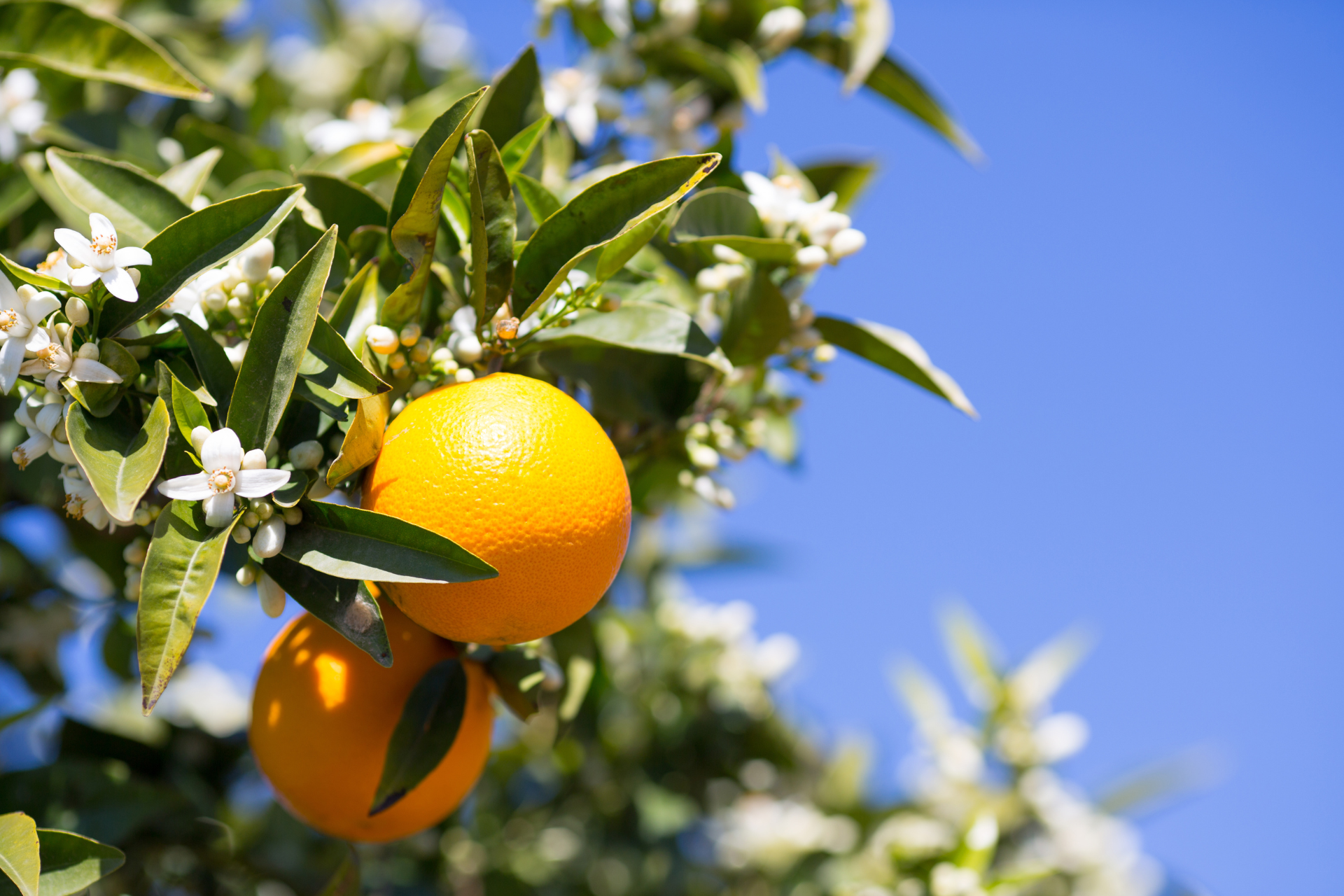
The Valencia orange is known as the king of juicing oranges. Developed in the mid-19th century in California, this cultivar is prized for its thin skin, sweet taste, and extremely high juice content. Unlike other varieties, the Valencia orange matures late in the season, usually ripening between March and July — a trait that extends orange availability beyond the winter months.
Valencia oranges are often the primary variety used in commercial orange juice production. Their juice is not only flavorful but also less likely to separate or turn bitter over time, making it perfect for bottling and storage. This cultivar plays a crucial role in keeping the orange juice industry supplied year-round, especially when other cultivars are out of season.
For farmers, Valencias are a solid choice if they understand how to grow orange trees that need extended time on the branch. The fruit may stay on the tree for months after ripening without losing quality, allowing for staggered harvesting. However, their longer maturation cycle does require careful monitoring to prevent overripening and damage.
In consumer markets, Valencias are often sold as juicing oranges rather than for direct consumption. While their thin skin and occasional seeds make them less convenient for snacking, their superior juice quality continues to reinforce their value in both home kitchens and industrial production lines.
Navel
Navel oranges are among the most popular cultivars for fresh eating. Named for the small, navel-like formation at the blossom end of the fruit, these oranges are seedless, easy to peel, and bursting with flavor. The convenience and sweetness of navel oranges make them ideal for lunchboxes, snacks, and fruit platters.
Originating from a spontaneous mutation in Brazil in the early 19th century, navel oranges were introduced to the United States, where they quickly gained traction among growers. Today, they’re especially prevalent in California, where the orange tree thrives in dry, warm conditions perfect for this cultivar.
Unlike Valencia oranges, navels are not suitable for juicing on a large scale. Their juice turns bitter quickly due to the presence of a compound called limonin, which oxidizes after extraction. However, this drawback doesn’t affect their popularity for fresh consumption, where their low acidity and aromatic zest shine.
For those learning how to grow orange trees in home gardens, navels are a top recommendation. Their seedless nature and reliable fruiting habits make them a rewarding choice. With proper sunlight, irrigation, and pruning, even amateur growers can enjoy fresh, sweet navel oranges straight from their backyard.
Blood
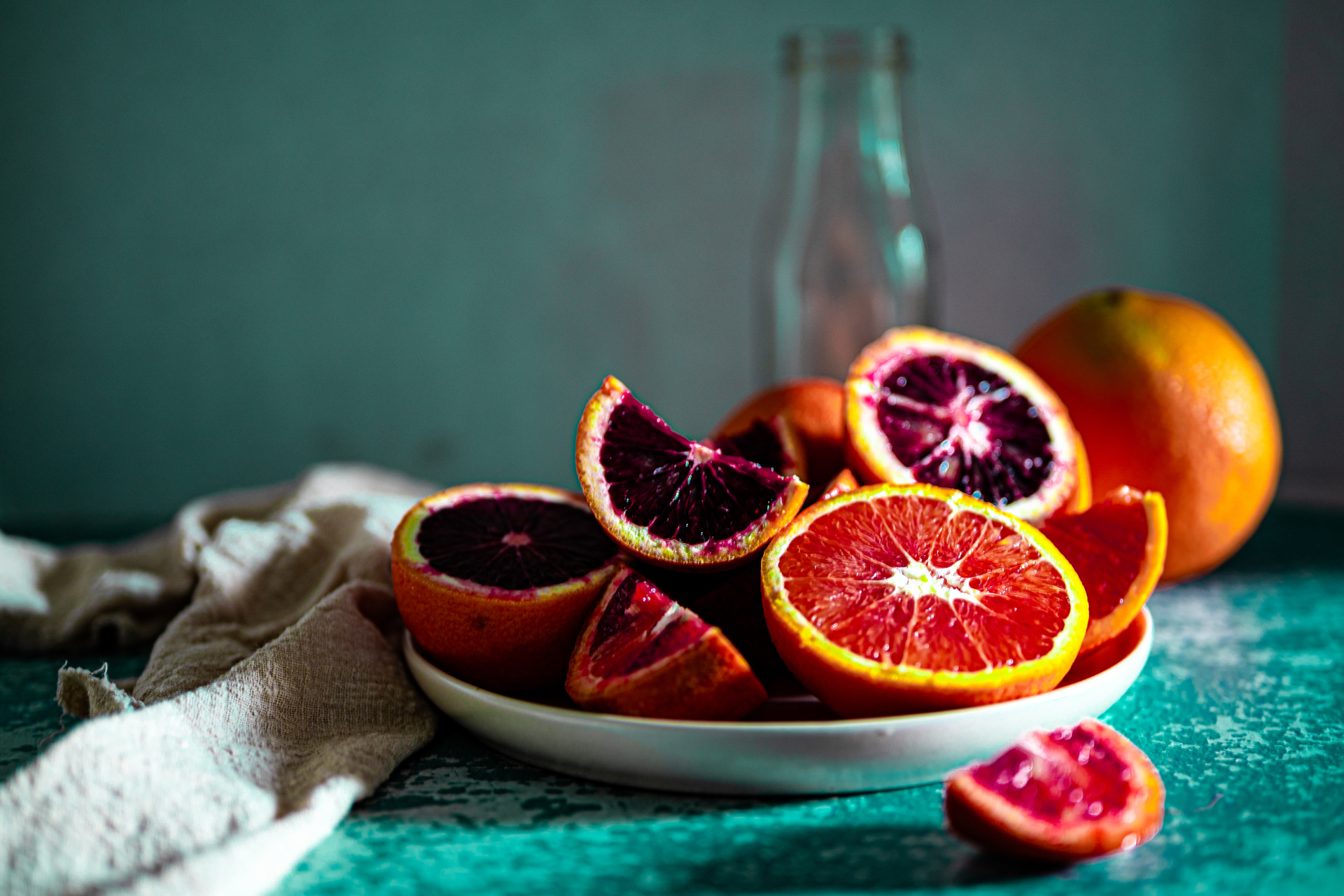
Blood oranges are a visually striking and richly flavored cultivar that has earned a niche following among chefs, foodies, and health enthusiasts. Their name comes from the deep red to maroon pigmentation in the fruit’s flesh, caused by anthocyanins, a type of antioxidant pigment not commonly found in other citrus fruits.
The taste of blood oranges is more complex than common oranges. They offer notes of raspberry, tart cherry, and citrus, making them excellent for both sweet and savory dishes. Their juice is vibrant in both color and flavor, often used in cocktails, desserts, and gourmet recipes.
In terms of the health benefits of oranges, blood oranges stand out. Their anthocyanin content may offer enhanced antioxidant protection, supporting cardiovascular health and reducing inflammation. These compounds, combined with high levels of vitamin C and fiber, make blood oranges a nutritious choice with unique appeal.
Cultivating blood oranges requires attention to specific climate needs. They perform best in regions with cool nights during the ripening season, which encourages the development of their deep red pigmentation. Knowing how to grow orange trees of the blood variety can be slightly more demanding, but the payoff, in both flavor and market value, is significant.
Acidless
Acidless oranges, also called sweet oranges or sugar oranges, are a lesser-known cultivar with extremely low acidity. These oranges have a mild, almost bland flavor that makes them less desirable for juicing or culinary use, but they serve a niche purpose. Their very low acid content makes them easier to eat for people with acid sensitivities or digestive issues.
The primary advantage of acidless oranges is their high sugar content paired with a soft texture. They’re generally consumed fresh and are not well-suited for storage or transportation, as their lack of acidity makes them more prone to spoilage. They also ferment quickly once juiced, so they are rarely used in commercial orange juice production.
From an agricultural perspective, acidless oranges are relatively easy to grow in warm climates. The orange tree for this cultivar grows similarly to other sweet orange types, requiring well-drained soil, ample sunlight, and protection from frost. However, due to their limited shelf life, they are usually sold close to their point of production.
Despite their lower market profile, acidless oranges still contribute to the diversity of orange cultivars and can be valuable in localized markets or home gardens. For people sensitive to citrus acidity, they offer a gentler alternative with all the natural sweetness of the orange family.

Health Benefits of Orange
Oranges are not just delicious — they are one of the most nutrient-rich fruits available. Packed with vitamin C, fiber, antioxidants, and essential minerals, the health benefits of oranges extend to nearly every system in the human body. Whether consumed as whole fruit or in the form of orange juice, oranges support immune function, heart health, skin health, and more.
One of the most well-known health benefits of oranges is their high vitamin C content. This powerful antioxidant helps protect cells from damage by neutralizing free radicals. It also boosts the production of white blood cells, which are critical for fighting infections. A single medium orange provides more than 100% of the recommended daily intake of vitamin C, making it a simple way to bolster immune health.
Oranges are also an excellent source of dietary fiber, especially when eaten whole rather than juiced. Fiber supports digestive health by improving bowel regularity and feeding beneficial gut bacteria. It can also help lower cholesterol levels, stabilize blood sugar, and promote a feeling of fullness, making oranges a smart snack for weight management. While orange juice contains some fiber, the whole fruit is significantly more effective in this regard.
Beyond fiber and vitamin C, oranges contain potassium, an essential mineral that plays a role in heart health. Potassium helps regulate blood pressure by balancing sodium levels in the body. Regular consumption of oranges may help reduce the risk of hypertension, stroke, and cardiovascular disease. For athletes or anyone concerned with hydration, the electrolyte balance provided by oranges and orange juice offers a natural, nutrient-rich alternative to sports drinks.
Oranges are also rich in phytochemicals such as flavonoids, carotenoids, and limonoids, which have anti-inflammatory and antioxidant properties. These compounds support cellular health, reduce the risk of chronic diseases like cancer and diabetes, and may even slow signs of aging. The synergy between vitamins, minerals, and phytochemicals makes the orange a holistic health food, far more powerful than the sum of its parts.
Cultivation
Growing oranges successfully depends on a variety of factors, including climate, soil, propagation methods, and post-harvest care. Understanding how to grow orange trees is essential, whether you’re a backyard gardener or a commercial grower. The orange tree requires careful planning and attention to detail throughout its lifecycle to ensure a bountiful and healthy yield.
Oranges thrive in well-drained, sandy loam soil with a slightly acidic pH. Proper irrigation, nutrient management, and pest control are necessary throughout the year. Trees need regular pruning to encourage airflow and sunlight penetration, which helps prevent disease and improves fruit quality. Fertilizers high in nitrogen, phosphorus, and potassium are used to support growth at different stages.
The choice of cultivar also affects cultivation strategy. For instance, Valencia oranges have a longer maturation period and are ideal for juicing, while navel oranges are better for fresh consumption and mature earlier. Growers must select varieties suited to their local conditions and market demand. Additionally, understanding local weather patterns and water availability plays a big role in successful cultivation.
Advances in agricultural technology, including drip irrigation and precision fertilization, have improved orange yields significantly. Whether for large-scale production or small garden setups, knowing how to grow orange trees the right way determines not only fruit quality but also the long-term viability of the orchard.
Climate
Climate is one of the most important factors when growing oranges. Orange trees flourish in subtropical and tropical regions with plenty of sunshine and minimal frost. Optimal temperature ranges from 55°F to 100°F (13°C to 38°C), although young trees are vulnerable to cold and may need protection in cooler climates.
Too much heat or prolonged drought can stress the orange tree, reducing fruit size and juice content. Conversely, too much rainfall or humidity can lead to fungal infections and root rot. That’s why well-drained soil and proper irrigation scheduling are key in maintaining tree health.
In regions like Florida and California, the combination of mild winters and warm summers creates ideal conditions for cultivating oranges year-round. However, sudden cold snaps or unexpected weather patterns can damage fruit and affect bloom cycles. Using windbreaks, frost cloths, or even orchard heaters can help mitigate risk in colder zones.
Climate-controlled greenhouses or tunnels are sometimes used for small-scale or experimental orange cultivation. These methods allow growers to simulate ideal weather conditions, but they can be cost-prohibitive for large farms. Regardless of scale, climate consideration is foundational in planning how to grow orange trees successfully.
Propagation
Orange trees are primarily propagated through grafting, a technique that involves joining the tissue of a desirable fruiting variety (scion) onto a hardy rootstock. This method ensures consistency in fruit quality and accelerates the time it takes for a tree to bear fruit. Grafting is preferred over growing from seeds, as seed-grown trees can take years to fruit and may produce inferior oranges.
The rootstock is selected based on soil compatibility, disease resistance, and climate adaptability. Common rootstocks for oranges include sour orange, trifoliate orange, and Carrizo citrange. Each offers different benefits, such as tolerance to salinity, drought, or specific diseases like Phytophthora root rot.
Budding is a common grafting method used in commercial orange tree propagation. In this process, a single bud from the scion is inserted into the bark of the rootstock and secured until it begins to grow. Once established, the rootstock is pruned back to encourage the bud to grow into the main trunk.
Propagation also includes nursery management, where young grafted trees are nurtured for one to two years before transplanting to orchards. Proper spacing, watering, and pest management during this stage are critical for producing strong, productive orange trees.
Harvest
Orange harvest timing depends on the cultivar and climate. Generally, oranges are picked when they reach full color and optimal sugar-to-acid ratio. For instance, navel oranges are usually harvested from late fall to early winter, while Valencia oranges can be picked in the summer months. A delayed harvest can enhance sweetness but also increase the risk of spoilage or pest damage.
Harvesting is usually done by hand to avoid bruising or damaging the fruit. Workers use clippers or gently twist and pull the fruit from the branches. Mechanical harvesters are used in some commercial operations, though they are more common with juicing oranges, where cosmetic damage is less of a concern.
Proper harvest practices also involve monitoring fruit maturity using tools like refractometers (to measure sugar content) and titration kits (for acidity). This ensures that oranges meet quality standards, especially if they are destined for export or premium markets. A premature harvest may result in fruit that looks ripe but lacks flavor.
Post-harvest handling includes immediate cooling to slow down respiration, careful sorting, and transportation under controlled conditions. Poor harvesting and handling can lead to a rapid decline in quality, impacting shelf life, appearance, and juice content.
Degreening
Degreening is a post-harvest process used to improve the appearance of oranges by removing green pigmentation from the peel. While the internal quality of the fruit may be excellent, external color sometimes lags behind, especially in warmer climates where cooler temperatures needed for natural coloring are absent.
Ethylene gas is commonly used in degreening chambers to trigger the breakdown of chlorophyll in the peel. The process usually takes 48 to 72 hours at controlled temperatures and humidity. Importantly, degreening does not affect the taste, nutritional value, or safety of the orange — it’s purely a cosmetic treatment.
This method is widely used in commercial operations to meet consumer expectations, particularly in markets where fully orange skin is equated with ripeness and quality. Without degreening, some markets might reject otherwise perfectly ripe fruit simply based on appearance.
While effective, degreening must be done carefully. Overexposure to ethylene or improper conditions can cause rind injury or uneven coloring. Skilled handling ensures that the final product is attractive without compromising the integrity of the fruit.
Storage
Storage plays a critical role in maintaining orange quality after harvest. Once picked, oranges continue to respire, slowly losing moisture and degrading in flavor and texture. Proper storage conditions can extend shelf life and preserve nutritional content, especially vitamin C.
Ideal storage for fresh oranges is in a cool, humid environment — typically around 38°F to 48°F (3°C to 9°C) with 85-95% relative humidity. These conditions slow down respiration and microbial growth while minimizing water loss. Cold storage is particularly important for oranges intended for export or long-term distribution.
For orange juice, pasteurization and refrigeration are standard practices to extend shelf life and prevent spoilage. Fresh-squeezed juice has a shorter shelf life and should be consumed within a few days, while commercially processed juice can last for weeks if unopened and refrigerated.
Storage methods also include packaging innovations like wax coatings, modified atmosphere packaging, and antimicrobial treatments. Each of these helps protect the fruit during transport and retail display. Good storage practices ensure that consumers receive oranges that are both visually appealing and nutritionally intact.
Pests and Diseases
Orange trees, like all crops, are susceptible to a range of pests and diseases that can impact yield, fruit quality, and tree health. Preventive management and early detection are crucial in maintaining a healthy orange orchard. Integrated pest management (IPM) strategies are often employed to minimize the use of chemicals while effectively controlling threats.
Commercial growers invest heavily in monitoring and controlling pests and diseases because the stakes are high. A single outbreak can damage thousands of orange trees and significantly reduce harvests. By understanding the biology of these threats, growers can implement targeted treatments that protect the orange crop with minimal environmental impact.
Resistant rootstocks, proper irrigation, regular pruning, and strategic pesticide use are all part of a comprehensive defense plan. In addition, many growers are now turning to organic methods, biological control agents, and disease-resistant cultivars as sustainable alternatives.
Maintaining orchard hygiene is also vital. This includes removing fallen fruit, cleaning tools, and avoiding excess moisture that can encourage fungal growth. When done correctly, these practices create an environment where the orange tree can thrive, free from the stress of infestations.
Pests
Common pests that attack orange trees include aphids, citrus leafminers, scale insects, and mites. These pests feed on plant sap or foliage, weakening the tree and reducing fruit yield. They also create entry points for secondary infections and attract ants that further disrupt the tree’s natural defenses.
The Asian citrus psyllid is a particularly dangerous pest because it spreads Huanglongbing (HLB), also known as citrus greening disease. This disease has devastated citrus orchards worldwide and has no known cure. Early detection and eradication of infected trees are essential to containing their spread.
Natural predators such as ladybugs, lacewings, and parasitic wasps can help control pest populations. These beneficial insects are an important part of biological pest management, reducing the need for synthetic pesticides. Companion planting and trap cropping are other eco-friendly methods used to deter pests.
Pest management starts with monitoring. Sticky traps, pheromone lures, and regular inspections help detect infestations before they spread. Using targeted interventions based on pest life cycles ensures effective control with minimal environmental disruption.
Diseases
Orange trees are prone to several diseases, including fungal, bacterial, and viral infections. Citrus canker, caused by Xanthomonas bacteria, creates lesions on leaves, stems, and fruit, affecting both appearance and marketability. It spreads rapidly in wet, windy conditions and requires strict quarantine and sanitation measures.
Greasy spot and melanose are fungal diseases that cause black or brown blemishes on leaves and fruit. They thrive in humid environments and are managed through fungicide sprays and improved air circulation via pruning. Regular leaf litter removal also reduces spore buildup.
Tristeza virus is another serious threat that weakens the root system, leading to tree decline and death. Spread by aphids, this virus can decimate orchards if not properly managed. Planting resistant rootstocks is the best preventive measure.
Disease-resistant cultivars and grafting onto hardy rootstocks have become standard practices in commercial orchards. Coupled with regular monitoring and quick response to outbreaks, these methods ensure that the health benefits of oranges are preserved from tree to table.
Production
Global orange production is a multi-billion dollar industry, with Brazil, the United States, India, and China leading the way. Brazil dominates orange juice exports, while the U.S. (particularly Florida and California) plays a major role in both fresh fruit and juice markets. The orange’s economic value is immense, supporting millions of jobs worldwide.
Production begins with selecting the right cultivar and ensuring ideal growing conditions. From propagation to harvest, every stage is optimized to maximize yield and quality. Precision agriculture tools — like soil sensors, drone mapping, and automated irrigation — are increasingly common in modern orange production.
Yield per tree can vary significantly depending on the cultivar, climate, and care. A mature orange tree can produce between 200 to 350 oranges per year under ideal conditions. These figures scale massively in commercial orchards, where hundreds of acres can yield millions of fruits annually.
Post-harvest, the oranges are sorted, graded, and packed for various markets. Some are shipped as whole fruit, while others are juiced, frozen, or processed into products like concentrates and extracts. The entire supply chain, from grove to grocery store, is a finely tuned system that keeps the world supplied with this essential fruit.
Culinary Use

Dessert, Fruit, and Juice
Oranges are a staple in both sweet and savory dishes. Their refreshing flavor and juicy texture make them ideal for desserts such as fruit salads, tarts, cakes, and sorbets. In baking, orange zest and juice add a bright, citrusy punch to everything from muffins to glaze.
Freshly squeezed orange juice is a breakfast staple around the world. Beyond beverages, it’s used in marinades, salad dressings, and sauces. The acidity of orange juice can help tenderize meat, while its sweetness balances spicy or bitter ingredients.
Oranges pair well with herbs like mint and basil, and ingredients like dark chocolate, almonds, and fennel. Their versatility makes them a key ingredient in multicultural cuisines, from Middle Eastern salads to French patisserie.
Home cooks and professional chefs alike rely on the consistent quality and availability of oranges to elevate everyday recipes. Whether served as slices, juice, or a decorative garnish, oranges offer both flavor and flair.
Marmalade
Marmalade is one of the oldest and most beloved uses of oranges, especially the bitter Seville variety. Made by boiling orange peel and pulp with sugar and water, marmalade delivers a sweet and tangy spread with a distinct bitterness from the peel.
This preserve is a breakfast classic, often paired with toast, scones, or croissants. In addition to its culinary appeal, marmalade retains much of the nutritional value of the orange, especially its fiber and vitamin C content.
Making marmalade at home has become popular among food enthusiasts. It allows for customization in sweetness, thickness, and added ingredients like ginger or vanilla. The process also utilizes the entire fruit, reducing waste and increasing value.
In commercial settings, marmalade is often jarred and exported worldwide. It remains a symbol of refined taste and artisanal craft, keeping the legacy of orange preservation alive.
Extracts
Orange extracts and essential oils are made from the peel of the fruit and are widely used in flavoring, aromatherapy, and cleaning products. The oils contain limonene and other compounds that provide a strong, citrusy aroma and taste.
In baking, orange extract is used to intensify flavor without adding moisture. It’s a common ingredient in cakes, cookies, and candies. A few drops go a long way in enhancing both sweet and savory dishes.
Beyond the kitchen, orange oil is valued for its natural antibacterial properties and is used in homemade cleaners and skincare products. Its invigorating scent makes it a favorite in air fresheners and perfumes.
The versatility of orange extracts highlights how every part of the fruit, from flesh to peel, can be utilized. Whether in food or fragrance, these extracts carry the essence of the orange far beyond the fruit bowl.
In Human Culture
Oranges hold deep symbolic meaning in many cultures. In Chinese tradition, oranges are associated with prosperity and good fortune. They are commonly exchanged during Lunar New Year celebrations as a sign of wealth and happiness. The bright color and round shape symbolize completeness and success.
In Western societies, oranges are often linked with health, energy, and morning routines. The phrase “orange juice” is practically synonymous with breakfast. Marketing campaigns have reinforced this image, embedding the orange as a daily ritual and a symbol of vitality.
Historically, oranges were luxury items in Europe, often gifted during Christmas or used to decorate feasts. The fruit was rare, and its availability signaled wealth and global connection. Orangeries on royal estates showcased exotic citrus trees as symbols of power and sophistication.
Today, oranges are a global icon. From pop culture references to national agricultural symbols, the orange continues to inspire and sustain. Its role in human culture reflects not only its flavor and nutrition but also its adaptability and lasting appeal.

